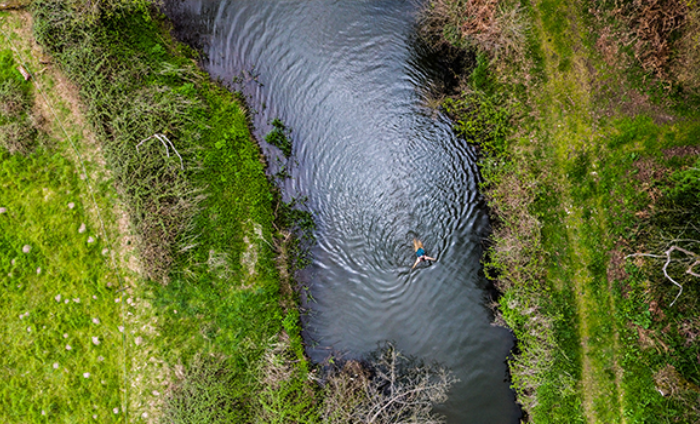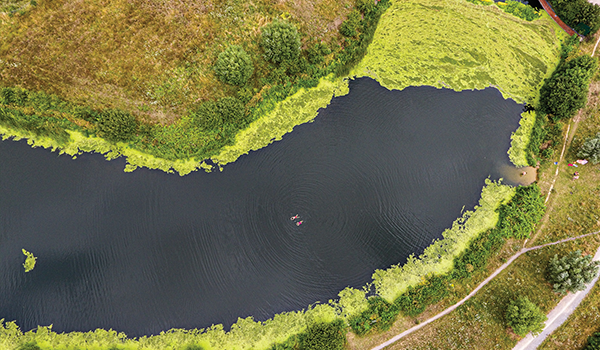
Wild Swimming: How to spot a clean river
The state of UK rivers is a hot topic in the media, but are they safe to swim in? Dip Advisor Ella Foote explains how to identify a river clean enough for a dip
Despite the national media reports about the state of the UK rivers, swimming in a river is relatively safe and like a lot of outdoor swimming, if you apply some common sense and do a little research you can reduce some of the risks. As a swim guide and coach one of the most common questions I get asked about swimming in rivers is whether it is clean. No river water is going to be clean enough to consume, but understanding water quality in rivers will help you identify when it isn’t right to plunge in?
Trust your instincts
You know that icky feeling you get when something doesn’t feel right? Well, we need to trust that. It is your senses alerting you to risk. I often tell swimmers to think about sight, smell, touch and taste – yes taste! While I am not encouraging you to slurp a sample of water, you can taste metallic like flavour when near industrial polluted water, its uncommon but worth noting. What you are more likely to notice is smell – if water doesn’t smell right – it probably isn’t right. If there is a scum or a film on the water, or a high level of weed and algae it won’t be clean enough for a swim – nor enjoyable.
Wildlife, flowers, and fauna are great natural indicators of healthy water.
Birds, fish, plants and insects don’t like dirty water, if there are dragonflies, pond skaters, birds dipping and fish jumping – get in and join them.

The Rivers Trust wants people to enjoy rivers as much as we do. You can find information on how to swim safely in rivers. Visit: theriverstrust.org
Weeds and algae
Most river weeds are harmless and naturally abundant in summer months. If a river is shallow, you will encounter more weeds or in bigger rivers in the shallows near riverbanks. I encourage swimmers who dislike weed to embrace it, learn about the different kinds and let the weeds brush their legs. Long grass like weed is easy to swim over or through, but if there are lily pads, floating weed or large leafy weeds, you are likely to get more tangled. No weed can pull you to the depths like you imagine, but weeds can wrap around your legs and cause panic. Swim in deeper water, or when river levels are a bit higher. Algae blooms are more concerning. Large areas of dense floating weed and green murky water can indicate high levels of nitrates, phosphates, and toxins. Blue-green algae can be toxic if swallowed, or cause rashes and itchiness to the skin if splashed on the body and fatal to dogs. It is easy to spot and often smells bad, you can taste it in the air and looks green and scummy.
Sewage
It is a sad truth that water companies are still guilty of pumping raw sewage into our rivers and seas. It is especially bad after heavy rainfall when archaic systems fail due to lack of investment in the infrastructure. It is also worth noting that water companies also pump treated water back into our waterways and this can also impact water quality. There are several reports you can find about when sewage is released into coastal waters, websites like Magic Seaweed and Surfers Against Sewage are good resources.
For rivers, The Rivers Trust recently produced an active map that shows where the sewerage network discharges treated effluent and overflows of untreated effluent and storm water into rivers. It means you can identify and avoid entering the water immediately downstream of these discharges and avoid the overflows, especially after it has been raining.
Bacteria and sickness
Fortunately, sickness from outdoor swimming is rare and often just results in an upset tummy, with sickness and/ or diarrhoea. It is why the general advice is not to swim after heavy rainfall. Water and everything else washes into our waterways from both urban and agriculture land. There is often more natural debris too, like branches and floating hazards.
Also, if you spend a lot of time in the water and inefficiently take on water while breathing/swimming you can be more susceptible to an upset tummy. It is a good reason to polish up your swimming strokes! Common fear-mongering is around Weil’s disease which is a form of bacterial infection called leptospirosis. It is rare in the UK, around 50 reported cases a year and some of these are acquired abroad. It’s still important to reduce your risk. Make sure than any cuts are covered with waterproof plasters, and never swim in stagnant water and wash hands after swimming before eating or drinking.
Be prepared and enjoy!
Learning about rivers and all the national press surrounding water quality can really put a swimmer off, but rivers are super places to swim. They are great for swimming journeys and what is in a river today will be gone by tomorrow. They are ever changing, evolving and growing. Seasonally they change significantly.
Spring and autumn are my favourite time for river swimming, less weeds and cooler water. But a briny estuary swim in late autumn with the warmth of the sea is especially lovely too.
Report it
While you’re out, if you spot a pollution incident, any illegal activity or anything else, please report it immediately to the environment authorities.
England, Scotland and Northern Ireland: 0800 80 70 60
Wales: Natural Resources Wales hotline: 0300 065 3000
Ireland: EPA Headquarters: 053 916 0600









